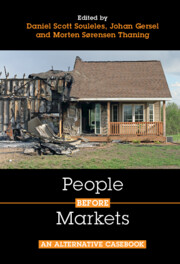Book contents
- People Before Markets
- People Before Markets
- Copyright page
- Dedication
- Contents
- Contents by Topic
- Authors
- 1 Introduction: Why Are You Here?
- 2 Some Philosophical Help with “Neoliberalism”
- Part I Our World
- 3 Where Should Food Come From?
- 4 Where Should Water Come From?
- 5 Who Gets to Own Land?
- 6 How Should Food be Produced?
- 7 Who Decides Where They Live?
- 8 How Much Land Do We Need?
- 9 Where Should We Park?
- 10 How Should We Deal with Climate Change?
- 11 How Should We Make an Impact?
- Part II Our Lives
- Part III Our Work
- Index
- References
3 - Where Should Food Come From?
from Part I - Our World
Published online by Cambridge University Press: 27 October 2022
- People Before Markets
- People Before Markets
- Copyright page
- Dedication
- Contents
- Contents by Topic
- Authors
- 1 Introduction: Why Are You Here?
- 2 Some Philosophical Help with “Neoliberalism”
- Part I Our World
- 3 Where Should Food Come From?
- 4 Where Should Water Come From?
- 5 Who Gets to Own Land?
- 6 How Should Food be Produced?
- 7 Who Decides Where They Live?
- 8 How Much Land Do We Need?
- 9 Where Should We Park?
- 10 How Should We Deal with Climate Change?
- 11 How Should We Make an Impact?
- Part II Our Lives
- Part III Our Work
- Index
- References
Summary
Most people who eat aren’t able to see much of our contemporary food system. This is deliberate. As world population has grown, so too has the food system become increasingly elaborate, specialized, and industrialized, all to the point that even those who live near fields or farms can likely only see a part of where our food comes from. This chapter explains a bit of how this system works, and what values it prioritizes. King and Rissing suggest that much of the food system is guided by a sort of market imperialism that values growth in yields and profit over other values that we might associate with food, values such as nutrition, variety, and environmental sustainability. It also demonstrates how neoliberal marketization does not function independently of public government but is sustained and developed by government interventions. By contrast, King and Rissing look at nonindustrial contemporary food systems to show what alternatives might look like, and to illustrate just how well they can address many of the values and aspirations we have for food systems. The alternative approach with its emphasis on food sovereignty, challenges the international frameworks of neoliberal governance that prioritizes the stimulation of market competition.
Keywords
- Type
- Chapter
- Information
- People before MarketsAn Alternative Casebook, pp. 57 - 78Publisher: Cambridge University PressPrint publication year: 2022



